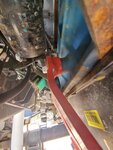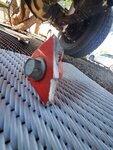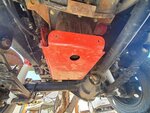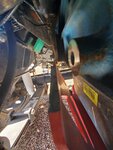You are using an out of date browser. It may not display this or other websites correctly.
You should upgrade or use an alternative browser.
You should upgrade or use an alternative browser.
Skid Plate issue
- Thread starter DesertRox
- Start date
- Joined
- Mar 10, 2019
- Messages
- 2,292
- Points
- 113
- Location
- Hurricane, WV, USA
- Roxor Ownership
- Roxor Owner
- Roxor #
- 2507
Wow, not good. I haven't heard of it, that I can think of. Is it cheap metal or just a fluke?
DesertRox
Active member
Looks like aluminum and where they welded it was discolored a little so maybe it fatigued at that point.
- Joined
- Apr 20, 2020
- Messages
- 796
- Points
- 63
- Location
- Palmer, AK, USA
- Roxor Ownership
- Roxor Owner
- Roxor #
- 7262
You're the 2nd person on this forum so far that has run into this issue.
OffRoad709
Active member
- Joined
- Feb 21, 2022
- Messages
- 172
- Points
- 43
- Location
- Newfoundland
- Roxor Ownership
- Roxor Owner
- Roxor #
- 1947
Mine broke too lol. Just started rattling 🙄. I'll find out what it's made from when my buddy re-welds it for me lolWow, not good. I haven't heard of it, that I can think of. Is it cheap metal or just a fluke?
Hummingbird Ranch
Active member
That is a fatigue crack, you can see the beach lines. Crack started at a stress concentration. This is a factory defect, either in the design or the manufacture. You should demand a replacement from the manufacturer.
- Joined
- Jun 13, 2019
- Messages
- 437
- Points
- 63
- Location
- Prescott, AZ, USA
- Roxor Ownership
- Roxor Owner
- Roxor #
- 02776
Yep. Mine cracked and made a vibrating sound that made you think you weren't going to make it home.
OffRoad709
Active member
- Joined
- Feb 21, 2022
- Messages
- 172
- Points
- 43
- Location
- Newfoundland
- Roxor Ownership
- Roxor Owner
- Roxor #
- 1947
7 yrs old I'm doubtful that will happen. I'll just fab one up at work . Rather get $50/hr to work on my rig haha.That is a fatigue crack, you can see the beach lines. Crack started at a stress concentration. This is a factory defect, either in the design or the manufacture. You should demand a replacement from the manufacturer.
The OEM Plate looks a lot more substantial than the version that glues on the bottom of the pan. I am surprised that so many have broken over the years. The OEM Oil Pan Skid Plate must have a design issue causing the failures.
On The Rox and Roxor Off Road both have Skid Plates Under $200 that look a lot like the OEM, but probably are an improvement over OEM I would hope. I am sure that both are a vast improvement over No Skid Plate at all or the Glue on version.
The Best Option seems to be Cecco Racings version which is also a little more expensive.
I guess the question would be how well protected do you need to be.
OK with None at All??
Is a Glue on Aluminum Plate enough to help you sleep at night??
OEM and hope it does not break??
Are On The Rox or Roxor Off Road's versions substantial enough??
Then we have Cecco Racing's version.
I believe that Max A has Cecco Skid Plates, (Oil Pan, Transfer Case, and Fuel Tank) on his Off Road Racing Rig, and he has even armored them up a little more for rock crawling. That is a pretty good endorsement for Cecco if you really need some serious protection.
I do not Rock Crawl at all, and so far I have not installed Skid Plates on my Roxor. I do try and be very careful especially around stumps in fields. I do get in a position where I think having Skid Plates would be a real good idea once in a while. It would be cheaper to invest in skid plates, than to pay for the repairs caused by not having them. A few Hundred for a Skid Plate vs Thousands for an Engine Replacement or Rebuild. The Skid Plate is about like having Insurance. It does not do a lot of good, until you need it.
Bob R
On The Rox and Roxor Off Road both have Skid Plates Under $200 that look a lot like the OEM, but probably are an improvement over OEM I would hope. I am sure that both are a vast improvement over No Skid Plate at all or the Glue on version.
The Best Option seems to be Cecco Racings version which is also a little more expensive.
I guess the question would be how well protected do you need to be.
OK with None at All??
Is a Glue on Aluminum Plate enough to help you sleep at night??
OEM and hope it does not break??
Are On The Rox or Roxor Off Road's versions substantial enough??
Then we have Cecco Racing's version.
I believe that Max A has Cecco Skid Plates, (Oil Pan, Transfer Case, and Fuel Tank) on his Off Road Racing Rig, and he has even armored them up a little more for rock crawling. That is a pretty good endorsement for Cecco if you really need some serious protection.
I do not Rock Crawl at all, and so far I have not installed Skid Plates on my Roxor. I do try and be very careful especially around stumps in fields. I do get in a position where I think having Skid Plates would be a real good idea once in a while. It would be cheaper to invest in skid plates, than to pay for the repairs caused by not having them. A few Hundred for a Skid Plate vs Thousands for an Engine Replacement or Rebuild. The Skid Plate is about like having Insurance. It does not do a lot of good, until you need it.
Bob R
Hummingbird Ranch
Active member
That is how fatigue works. A crack initiates at a stress concentration on the surface, caused by a gouge, or sharp transition, or corrosion pit, or even weld, etc., due to cyclic loads far below the design or ultimate loads or stresses the part is designed to handle. Once the crack initiates it continues to grow as the loads continue to cycle, creating beach lines emanating from the initiation site outward until finally there is not enough intact cross section of material left to carry the ultimate load and the part fractures due to overload with fast fracture. Parts are usually designed to have a fatigue life of generally 2 times the design life of the part to ensure that the part never fails from fatigue, but a design error or manufacturing flaw can cause the failure within the design life of the part. A skid plate designed and manufactured correctly should never fail from fatigue in your lifetime on a ground vehicle. The fracture surface in the photos is unmistakable showing fatigue cracking until finally fast fracture of the remaining material. The primary cyclic loads in the case of the skid plate, if it is only attached to the engine and not tied to the frame, are thermal cycles due to the temperature cycles every time the vehicle is warned up and then cooled down due to the thermal expansion and contraction of the engine, and likely also to a lessor degree the inherent vibration of the engine.7 yrs old I'm doubtful that will happen. I'll just fab one up at work . Rather get $50/hr to work on my rig haha.
Last edited:
- Joined
- Jun 13, 2019
- Messages
- 437
- Points
- 63
- Location
- Prescott, AZ, USA
- Roxor Ownership
- Roxor Owner
- Roxor #
- 02776
I'm certainly no expert, but is aluminum the right material for a skid plate?
Hummingbird Ranch
Active member
It could be made to work if it was in the annealed state as opposed to heat treated, but I would simply use a mild steel, as the mild steel is much less brittle than even an annealed aluminum and would simply yield and bend rather than fracture like hard aluminum. Where weight is not an issue like on a 4x4, I would not choose aluminum for a skid plate. A well designed 3/8 inch thick mild steel skid plate would be bullet proof, and never suffer a fatigue failure in your lifetime. Even a 1/4 inch thick mild steel skid plate would suffice for most users, other than maybe Max A. If the aluminum one broke at the weld, it is likely due to the heat affected zone around the weld made that area much harder and more brittle and more susceptible to fatigue cracking. That could have been remedied by baking the whole part and slowly cooling it to ensure it was all annealed and remove any residual stresses caused by the welding. Residual stresses are not good for fatigue resistance unless they are compressive like those achieved by cold working a hole or peening the surface.
OffRoad709
Active member
- Joined
- Feb 21, 2022
- Messages
- 172
- Points
- 43
- Location
- Newfoundland
- Roxor Ownership
- Roxor Owner
- Roxor #
- 1947
The skid plate i have is some cheap aluminum type material. See if I can make my own this week when I got back to work. Probably take my old one with me as a guide lol. Love to have the full skid plate set up but being in Canada the exchange and border fee's make it super expensive.The OEM Plate looks a lot more substantial than the version that glues on the bottom of the pan. I am surprised that so many have broken over the years. The OEM Oil Pan Skid Plate must have a design issue causing the failures.
On The Rox and Roxor Off Road both have Skid Plates Under $200 that look a lot like the OEM, but probably are an improvement over OEM I would hope. I am sure that both are a vast improvement over No Skid Plate at all or the Glue on version.
The Best Option seems to be Cecco Racings version which is also a little more expensive.
I guess the question would be how well protected do you need to be.
OK with None at All??
Is a Glue on Aluminum Plate enough to help you sleep at night??
OEM and hope it does not break??
Are On The Rox or Roxor Off Road's versions substantial enough??
Then we have Cecco Racing's version.
I believe that Max A has Cecco Skid Plates, (Oil Pan, Transfer Case, and Fuel Tank) on his Off Road Racing Rig, and he has even armored them up a little more for rock crawling. That is a pretty good endorsement for Cecco if you really need some serious protection.
I do not Rock Crawl at all, and so far I have not installed Skid Plates on my Roxor. I do try and be very careful especially around stumps in fields. I do get in a position where I think having Skid Plates would be a real good idea once in a while. It would be cheaper to invest in skid plates, than to pay for the repairs caused by not having them. A few Hundred for a Skid Plate vs Thousands for an Engine Replacement or Rebuild. The Skid Plate is about like having Insurance. It does not do a lot of good, until you need it.
Bob R
OffRoad709
Active member
- Joined
- Feb 21, 2022
- Messages
- 172
- Points
- 43
- Location
- Newfoundland
- Roxor Ownership
- Roxor Owner
- Roxor #
- 1947
100% correct , cracked right along the edge of the weld.That is how fatigue works. A crack initiates at a stress concentration on the surface, caused by a gouge, or sharp transition, or corrosion pit, or even weld, etc., due to cyclic loads far below the design or ultimate loads or stresses the part is designed to handle. Once the crack initiates it continues to grow as the loads continue to cycle, creating beach lines emanating from the initiation site outward until finally there is not enough intact cross section of material left to carry the ultimate load and the part fractures due to overload with fast fracture. Parts are usually designed to have a fatigue life of generally 2 times the design life of the part to ensure that the part never fails from fatigue, but a design error or manufacturing flaw can cause the failure within the design life of the part. A skid plate designed and manufactured correctly should never fail from fatigue in your lifetime on a ground vehicle. The fracture surface in the photos is unmistakable showing fatigue cracking until finally fast fracture of the remaining material. The primary cyclic loads in the case of the skid plate, if it is only attached to the engine and not tied to the frame, are thermal cycles due to the temperature cycles every time the vehicle is warned up and then cooled down due to the thermal expansion and contraction of the engine, and likely also to a lessor degree the inherent vibration of the engine.
Jesse Torque King 4x4
Member
Knock on wood (mine hasn't broke yet), it seems you have to use the bejeebus out of these skid plates for them not to crack. Or, maybe they crack but impact weld themselves back together....
Steel would've been a better choice.
Steel would've been a better choice.
- Joined
- Dec 29, 2023
- Messages
- 207
- Points
- 43
- Location
- Georgia, LaGrange
- Roxor Ownership
- Roxor Owner
- Roxor #
- 10480
Wait, you guys are telling me your Roxor came with an oil pan skid plate? From the factory? Hmm, maybe they just eliminated it altogether for the 23 models. I have the On The Rox skid plate now. Interesting.
Similar threads
- Replies
- 9
- Views
- 2K




